Antonio Jesús Luna is co-editor at ROOM Diseño, the Spanish architecture and design magazine that launched in 2012. A man who has built a fascinating career around words, communication and language, Antonio studied philology and worked in various literary capacities, before assuming the role of editor at ROOM.

Antonio Jesús Luna.
Here, in our people with character series, we talk with Antonio about his views on architecture and design, his design heroes, the perennial paper vs digital debate, and the evolution of ROOM Diseño.
You have a degree and background in philology. What then attracted you to architecture and design as a vocation?
(AJL) My professional life has always revolved around words. Initially, when I started out, my professional construction began in the world of literature: as a critical voice in different media—Ajoblanco, Vanidad, El Urogallo—and a literary advisor and proofreader in publishing/editorial environments, including: Espasa Narrativa, Alfaguara and Lengua de Trapo.
I would say that I’ve never conceived my professional identity in a static way. I came to design and architecture in an unexpected manner, where suddenly, life had a different plan. I was part of the REM Magazine team from 2004–2011 (when it closed). REM was a publication concerned with both design and architecture. Joining REM caused me to stop being just an admirer of these disciplines, and to start thinking about them much more rigorously. In this sense, I have a ‘regulated’ education in philology, whereas my training in the field of design has been self-taught, spontaneous and even undisciplined in nature. In any case, philology is still present: much of my work in ROOM Diseño has to do with words, narratives, and the way of telling readers about projects.

Describe your design aesthetic.
(AJL) The designer Charles Eames once said his dream was ‘to have people working on useless projects. These have the germ of new concepts.’ This quote defines my own design vision. In ROOM we are attracted to peripheral design, the design that seeks new languages and new creative ways, even at the risk of making mistakes and missing the shot. For Emerio Arena—my co-editor at ROOM Diseño—and myself, the exciting things happen on those secondary roads: in that space where taking risks and searching are the starting points and the points of arrival.
Who are you watching in today’s architecture and design arenas: who is triggering your curiosity?
(AJL) I love residential architecture in Japan. Much more than just homes, the buildings often look like housing experiments. I would call attention to Japanese architect Sou Fujimoto’s work in particular. Also in Japan, I very much admire designer Oki Sato (of Nendo) for his ability to create objects and spaces between the subtle and the almost imperceptible.
I’m very interested in work by creators such as: Slovenian designer Nika Zupanc, British designer Benjamin Hubert, the art–design collective Numen/For Use, Amsterdam-based artist collective Studio Drift, Israeli artist Arik Levy, New York-based collaborative practice Snarkitecture, Dutch ‘food’ or ‘eating’ designer Marije Vogelzang, and Spanish design studio Six N. Five.
In architecture, I am especially attracted to practices such as SelgasCano (whose work includes the Plasencia Auditorium and Congress Centre, a vitalist and chromatic ode in the Spanish city of Plasencia), and Ensamble Studio (whose Hemeroscopium house will speak to many generations to come).
Who are your design heroes—who inspires you creatively?
(AJL) I am very interested in the design that began to develop during the 1960s—design that questioned rationalism, incorporated the concept of playfulness, and launched new materials, techniques and possibilities. In particular, work by Italian designers Achille and Pier Giacomo Castiglioni, Cini Boeri and Gaetano Pesce, and by Finnish designer Eero Aarnio. Later, there was Italian radical design—Archizoom Associati, Studio 65 and Gruppo Strum, for example. This opened the door to a 1980s view of postmodernism, captured by names such as Alessandro Mendini, Andrea Branzi, Ron Arad and Marc Newson.
As a consequence, there is real interest in art–design at ROOM, the hybrid that gallerist David Gill describes as design and not design, art and not art, functional and not functional. We are also very attracted to avant-garde crafts, and see this area as a tremendously fruitful and expanding testing ground.

ROOM Diseño was launched in 2012. What has surprised and excited you most about its evolution to date?
(AJL) When we started ROOM in 2012, everything was hecatombe (sacrificed). Magazines were shut down, for example REM, and editorial groups closed many of their titles. It was a time when, in addition to the economic crisis, there was the paper crisis: the future of paper was questioned, with the rise of digital as a popular medium. In the past eight years, we have been excited to see that paper remains prevalent, and continues to make an impact.
In this sense, the evolution of ROOM has been directed in a way that makes the publication an object, a piece that the reader wants to keep. Therefore, it is essential that the type of paper—the weight, the printing, the smell—gives rise to a poetic and sensorial experience of reading, one that cannot be gained from reading on a digital platform.
We were also excited to see that our editorial line has found a place in the kiosk, and that our peripheral vision of contemporary creation adds more and more readers. Also, I don’t want to forget our collaborators—the writers who are specialists in their field. They have a unique ability to narrate a project, with both professional rigour and an almost literary drive.
What differentiates ROOM Diseño from its contemporaries?
(AJL) In addition to our editorial line, I believe our biggest difference can be found in our slow reading proposal. In these times of hypervelocity and information saturation, we publish only four issues of ROOM per year—as such, the reader has three months to browse and peruse a new edition of the magazine. We mirror this same strategy on the website, preferring to upload fewer posts, favouring work that is rigorous, analytical and not ‘copy and paste’.
In our hyper-digital age, we have this perennial fascination with paper versus digital. As a magazine editor, what are your thoughts on the merits of one medium over the other?
(AJL) Digital culture is part of our time and, of course, the ROOM business structure. Our digital channels (web/RRSS/newsletter) are communication tools, fully connected with the physical magazine. With regard to this, in the past eight years we have achieved an absolute relationship between our offline and online media, forming a hybrid means of reaching our reader, by land, sea and air. Each generates a different type of impact and a different type of reading. We have the immediacy of the screen or the pause offered by paper: two complementary ways of accessing information.

I sometimes wonder if Spanish design struggles to gain international recognition—what do you think is needed in order to define and promote Spanish design on a world stage?
(AJL) Across its varied disciplines, Spanish design has, without question, a number of big names: Nacho Carbonell, Jaime Hayon, Eugeni Quitllet and Leandro Cano, for example. Patricia Urquiola is probably the most influential designer in the world. She is Asturian, although she lives in Milan. Many Spanish design companies develop much of their business outside Spain.
I think that fundamentally, there is an educational issue with Spanish design. Its cultural value needs to be better understood in order to garner more public support. It is also essential that companies understand that investing in design is a successful strategy. I want to say that, in all probability, as Spanish design grows, it will continue to make its way out there.













